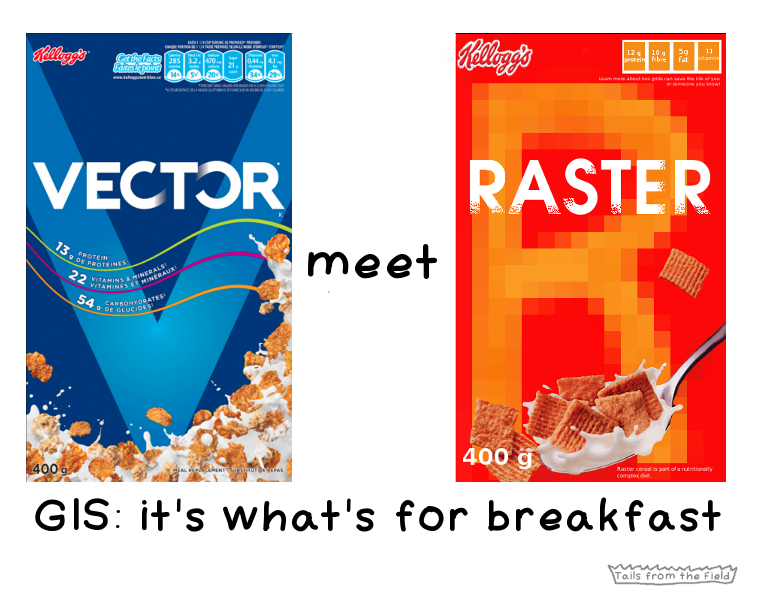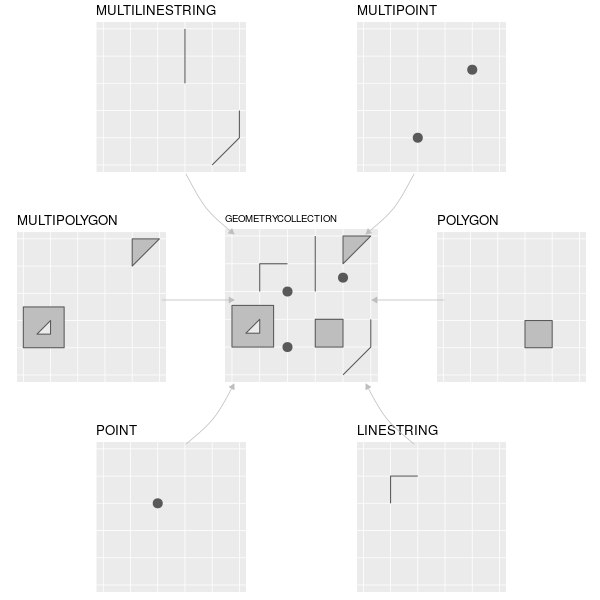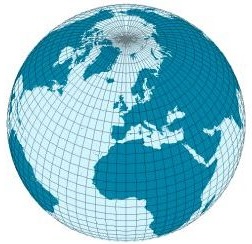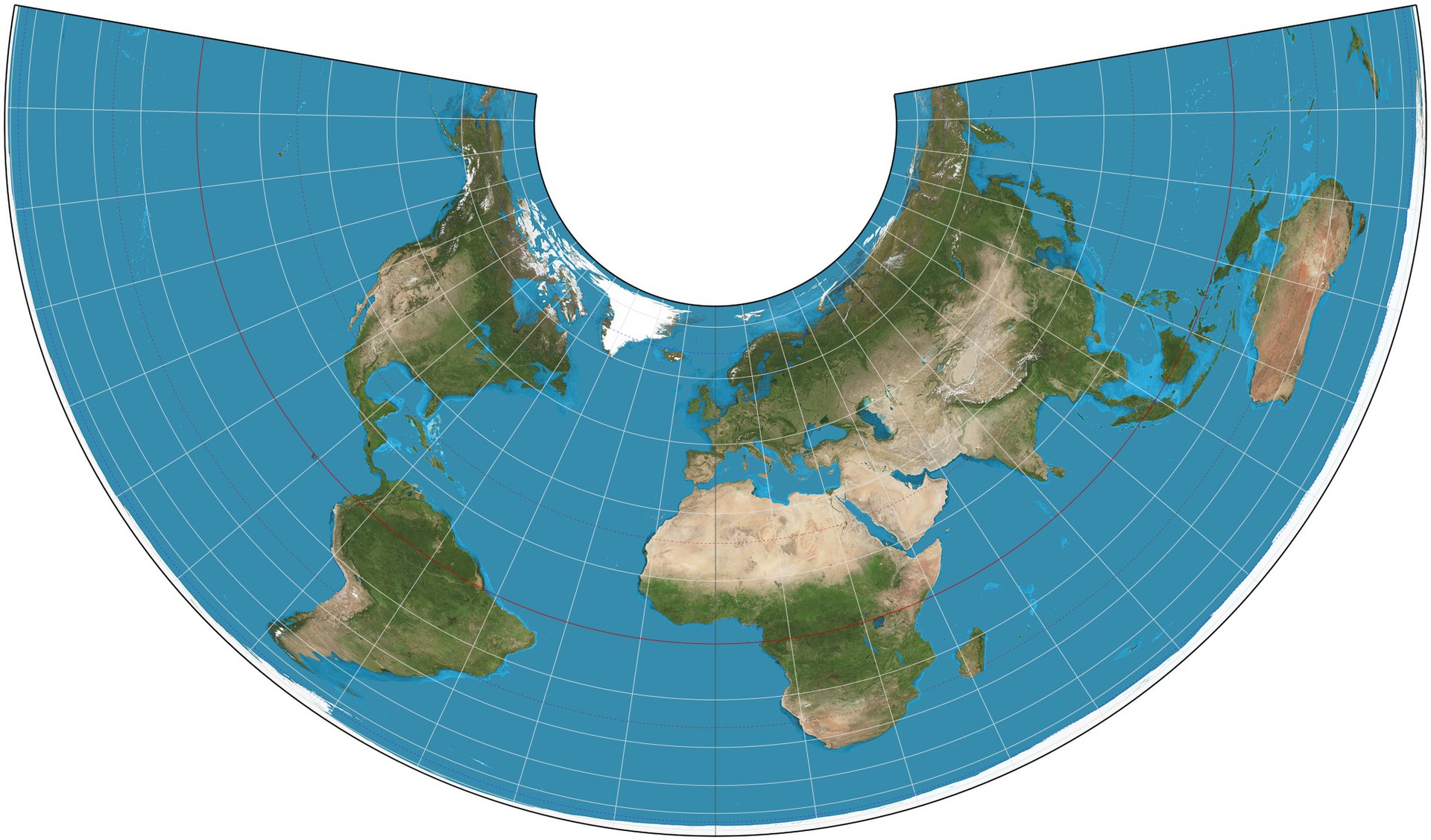Introduction to Spatial Data with R
Outline
- Introduction to Simple Features and the
sfpackage - Coordinate Reference Systems
- Reading various spatial data formats into R
- Basic operations with spatial data
Learning objectives
- The “simple features” representation of vector data
- Use and understand
sfobjects in R - Basic understanding of Coordinate Reference Systems (CRS)
- Use
mapviewandsfto preview spatial data - How to do basic operations with spatial data using
sf
Before we start
- Configure RStudio
- Get the course materials (if you haven’t already):
<etherpad.andyteucher.ca/p/r-telemetry-pg>

Vector: Simple Features
The sf R package1
Replaces
- sp
- rgdal
- rgeos
 2
2
Reading & previewing spatial data
mapview
Structure of an sf object
Simple feature collection with 455 features and 5 fields
Geometry type: POINT
Dimension: XY
Bounding box: xmin: 406543.7 ymin: 367957.6 xmax: 1796645 ymax: 1689146
Projected CRS: NAD83 / BC Albers
# A tibble: 455 × 6
AIRPORT_NAME IATA_CODE LOCALITY ELEVATION NUMBER_OF_RUNWAYS
<chr> <chr> <chr> <dbl> <int>
1 Terrace (Northwest Regional) … <NA> Terrace 217. 2
2 Victoria Harbour (Camel Point… <NA> Victoria 4.57 0
3 Victoria Inner Harbour Airpor… YWH Victoria 0 0
4 Victoria Harbour (Shoal Point… <NA> Victoria 3.05 0
5 Victoria (Royal Jubilee Hospi… <NA> Saanich 15.6 0
6 Victoria (General Hospital) H… <NA> View Ro… 15.8 0
7 Victoria (BC Hydro) Heliport <NA> Saanich 12.2 0
8 San Juan Point (Coast Guard) … <NA> Port Re… 7.62 0
9 Shawnigan Lake Water Aerodrome <NA> Shawnig… 0 0
10 Victoria International Airport YYJ North S… 19.5 3
# ℹ 445 more rows
# ℹ 1 more variable: geom <POINT [m]>Key features of an sf object
POINT (833323.9 1054950)POINT (1193727 381604.1)POINT (1194902 382257.7)POINT (1193719 382179.3)POINT (1198292 383563.6)Coordinate Reference System:
User input: NAD83 / BC Albers
wkt:
PROJCRS["NAD83 / BC Albers",
BASEGEOGCRS["NAD83",
DATUM["North American Datum 1983",
ELLIPSOID["GRS 1980",6378137,298.257222101,
LENGTHUNIT["metre",1]]],
PRIMEM["Greenwich",0,
ANGLEUNIT["degree",0.0174532925199433]],
ID["EPSG",4269]],
CONVERSION["British Columbia Albers",
METHOD["Albers Equal Area",
ID["EPSG",9822]],
PARAMETER["Latitude of false origin",45,
ANGLEUNIT["degree",0.0174532925199433],
ID["EPSG",8821]],
PARAMETER["Longitude of false origin",-126,
ANGLEUNIT["degree",0.0174532925199433],
ID["EPSG",8822]],
PARAMETER["Latitude of 1st standard parallel",50,
ANGLEUNIT["degree",0.0174532925199433],
ID["EPSG",8823]],
PARAMETER["Latitude of 2nd standard parallel",58.5,
ANGLEUNIT["degree",0.0174532925199433],
ID["EPSG",8824]],
PARAMETER["Easting at false origin",1000000,
LENGTHUNIT["metre",1],
ID["EPSG",8826]],
PARAMETER["Northing at false origin",0,
LENGTHUNIT["metre",1],
ID["EPSG",8827]]],
CS[Cartesian,2],
AXIS["(E)",east,
ORDER[1],
LENGTHUNIT["metre",1]],
AXIS["(N)",north,
ORDER[2],
LENGTHUNIT["metre",1]],
USAGE[
SCOPE["Province-wide spatial data management."],
AREA["Canada - British Columbia."],
BBOX[48.25,-139.04,60.01,-114.08]],
ID["EPSG",3005]]An sf object is a data.frame
[1] "sf" "tbl_df" "tbl" "data.frame"[1] TRUE AIRPORT_NAME IATA_CODE LOCALITY ELEVATION
Length:455 Length:455 Length:455 Min. : 0.0
Class :character Class :character Class :character 1st Qu.: 0.0
Mode :character Mode :character Mode :character Median : 6.4
Mean : 194.4
3rd Qu.: 307.1
Max. :1277.4
NUMBER_OF_RUNWAYS geom
Min. :0.0000 POINT :455
1st Qu.:0.0000 epsg:3005 : 0
Median :0.0000 +proj=aea ...: 0
Mean :0.3385
3rd Qu.:1.0000
Max. :3.0000 Coordinate Reference Systems
Geographic
- spherical or ellipsoidal surface
- ellipsoid defined by the datum
- lat/long, measured in angular distances (degrees/radians)

Projected
- Cartesian coordinates on a flat plane
- origin, x and y axes, linear unit of measurement (e.g., m)

CRSs in R: EPSG codes
BC Albers - B.C.’s standard projection
- Equal Area conic
- Centre: c(-126, 54)

https://epsg.io/3005
WKT (Well-Known Text)
Coordinate Reference System:
User input: EPSG:3005
wkt:
PROJCRS["NAD83 / BC Albers",
BASEGEOGCRS["NAD83",
DATUM["North American Datum 1983",
ELLIPSOID["GRS 1980",6378137,298.257222101,
LENGTHUNIT["metre",1]]],
PRIMEM["Greenwich",0,
ANGLEUNIT["degree",0.0174532925199433]],
ID["EPSG",4269]],
CONVERSION["British Columbia Albers",
METHOD["Albers Equal Area",
ID["EPSG",9822]],
PARAMETER["Latitude of false origin",45,
ANGLEUNIT["degree",0.0174532925199433],
ID["EPSG",8821]],
PARAMETER["Longitude of false origin",-126,
ANGLEUNIT["degree",0.0174532925199433],
ID["EPSG",8822]],
PARAMETER["Latitude of 1st standard parallel",50,
ANGLEUNIT["degree",0.0174532925199433],
ID["EPSG",8823]],
PARAMETER["Latitude of 2nd standard parallel",58.5,
ANGLEUNIT["degree",0.0174532925199433],
ID["EPSG",8824]],
PARAMETER["Easting at false origin",1000000,
LENGTHUNIT["metre",1],
ID["EPSG",8826]],
PARAMETER["Northing at false origin",0,
LENGTHUNIT["metre",1],
ID["EPSG",8827]]],
CS[Cartesian,2],
AXIS["(E)",east,
ORDER[1],
LENGTHUNIT["metre",1]],
AXIS["(N)",north,
ORDER[2],
LENGTHUNIT["metre",1]],
USAGE[
SCOPE["Province-wide spatial data management."],
AREA["Canada - British Columbia."],
BBOX[48.25,-139.04,60.01,-114.08]],
ID["EPSG",3005]]Your turn
Read in the electoral districts data in the raw_data folder:
- What type of geometry is it?
- What is the CRS?
- What is the EPSG code?
Solution
elec_bc <- read_sf("raw_data/bc_electoral_districts.shp")
st_geometry_type(elec_bc, by_geometry = FALSE)Coordinate Reference System:
User input: WGS 84
wkt:
GEOGCRS["WGS 84",
DATUM["World Geodetic System 1984",
ELLIPSOID["WGS 84",6378137,298.257223563,
LENGTHUNIT["metre",1]]],
PRIMEM["Greenwich",0,
ANGLEUNIT["degree",0.0174532925199433]],
CS[ellipsoidal,2],
AXIS["latitude",north,
ORDER[1],
ANGLEUNIT["degree",0.0174532925199433]],
AXIS["longitude",east,
ORDER[2],
ANGLEUNIT["degree",0.0174532925199433]],
ID["EPSG",4326]]Basic plotting

Basic plotting
Transforming coordinate systems
Or, if you have another object in the CRS you want to use:
Coordinate Reference System:
User input: NAD83 / BC Albers
wkt:
PROJCRS["NAD83 / BC Albers",
BASEGEOGCRS["NAD83",
DATUM["North American Datum 1983",
ELLIPSOID["GRS 1980",6378137,298.257222101,
LENGTHUNIT["metre",1]]],
PRIMEM["Greenwich",0,
ANGLEUNIT["degree",0.0174532925199433]],
ID["EPSG",4269]],
CONVERSION["British Columbia Albers",
METHOD["Albers Equal Area",
ID["EPSG",9822]],
PARAMETER["Latitude of false origin",45,
ANGLEUNIT["degree",0.0174532925199433],
ID["EPSG",8821]],
PARAMETER["Longitude of false origin",-126,
ANGLEUNIT["degree",0.0174532925199433],
ID["EPSG",8822]],
PARAMETER["Latitude of 1st standard parallel",50,
ANGLEUNIT["degree",0.0174532925199433],
ID["EPSG",8823]],
PARAMETER["Latitude of 2nd standard parallel",58.5,
ANGLEUNIT["degree",0.0174532925199433],
ID["EPSG",8824]],
PARAMETER["Easting at false origin",1000000,
LENGTHUNIT["metre",1],
ID["EPSG",8826]],
PARAMETER["Northing at false origin",0,
LENGTHUNIT["metre",1],
ID["EPSG",8827]]],
CS[Cartesian,2],
AXIS["(E)",east,
ORDER[1],
LENGTHUNIT["metre",1]],
AXIS["(N)",north,
ORDER[2],
LENGTHUNIT["metre",1]],
USAGE[
SCOPE["Province-wide spatial data management."],
AREA["Canada - British Columbia."],
BBOX[48.25,-139.04,60.01,-114.08]],
ID["EPSG",3005]]Your turn
Load "raw_data/ski_resorts.csv" as an sf object
| facility_name | locality | latitude | longitude | elevation |
|---|---|---|---|---|
| Wapiti Ski Club | Elkford | 50.02168 | -114.9380 | 1467 |
| Summit Lake Ski Area | Nakusp | 50.14546 | -117.6144 | 1132 |
| Sasquatch Mountain Resort | Hemlock Valley | 49.38011 | -121.9354 | 1185 |
| Apex Mountain Resort | Apex | 49.39042 | -119.9047 | 1852 |
| Salmo Ski Hill | Salmo | 49.18640 | -117.3015 | 864 |
| Red Mountain Resort | Rossland | 49.10238 | -117.8194 | 1150 |
Hints:
Load "raw_data/ski_resorts.csv" as an sf object
Solution
ski_resorts <- read.csv("raw_data/ski_resorts.csv")
ski_resorts <- st_as_sf(ski_resorts,
coords = c("longitude", "latitude"),
crs = 4326)
head(ski_resorts)Simple feature collection with 6 features and 3 fields
Geometry type: POINT
Dimension: XY
Bounding box: xmin: -121.9354 ymin: 49.10238 xmax: -114.938 ymax: 50.14546
Geodetic CRS: WGS 84
facility_name locality elevation geometry
1 Wapiti Ski Club Elkford 1467 POINT (-114.938 50.02168)
2 Summit Lake Ski Area Nakusp 1132 POINT (-117.6144 50.14546)
3 Sasquatch Mountain Resort Hemlock Valley 1185 POINT (-121.9354 49.38011)
4 Apex Mountain Resort Apex 1852 POINT (-119.9047 49.39042)
5 Salmo Ski Hill Salmo 864 POINT (-117.3015 49.1864)
6 Red Mountain Resort Rossland 1150 POINT (-117.8194 49.10238)Geometric calculations
Geometric Measurements
st_area()st_length()st_distance()
Geometric Operations
st_union()st_intersection()st_difference()st_sym_difference()
Geometry Predicates
Use with st_filter() or st_join()
st_intersects():
touch or overlapst_disjoint():
!intersectsst_touches(): touchst_crosses():
cross (don’t touch)st_within(): within
st_contains():
containsst_overlaps():
overlapsst_covers(): coverst_covered_by():
covered byst_equals(): equals
Manipulating Geometries
st_line_merge()st_segmentize()st_voronoi()st_centroid()st_convex_hull()st_triangulate()
st_polygonize()st_split()st_buffer()st_make_valid()st_boundary()- …
Your turn
- Calculate the area of each electoral district
- Create an sf object of only airports within the Nelson-Creston electoral district.
- Plot the ski resorts as circles, where the size of the circle is related to the elevation of the resort.



